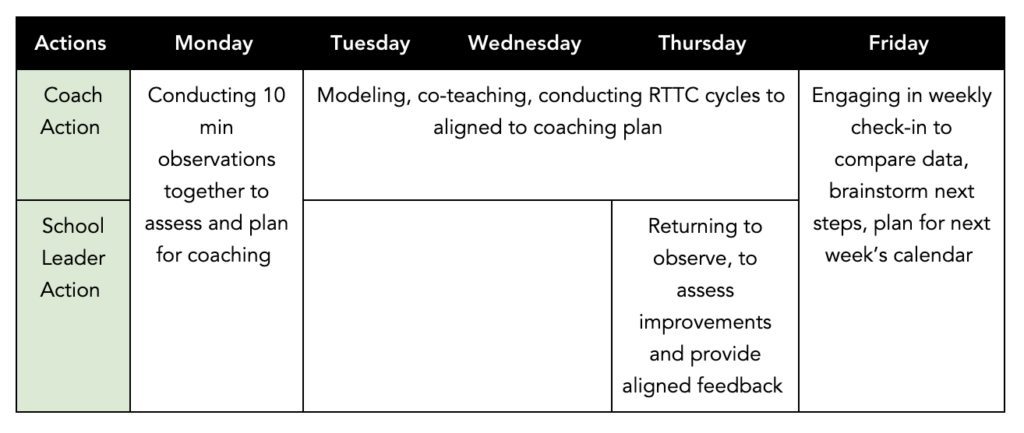In schools across our country, instructional coaches work to ensure each of their teachers get the support they need to be successful for students. School leaders are uniquely positioned to provide structure and explicit coaching to these folks, to ensure coach effectiveness as well as their feedback alignment. The steps below support an intentional relationship between leader and coach, for the growth of every teacher and student:
1. Calendar time at the start of each week to walk classrooms with each instructional coach.
Time is a school leader’s most precious resource and spending it shoulder-to-shoulder with an instructional coach is a highly effective way to spend it. A leader can leverage an end-of-week check-in with their coach to plan 10-minute observations the following Monday and/or Tuesday. They may select teachers across a range of skill levels or in a particular grade or content of focus; they may also select teachers whom the coach is having difficulty reaching. Regardless, this first step speaks to the power of shared classroom observation to drive a norming conversation around the highest leverage feedback. Check out CT3’s blog on Developing a Classroom Walkthrough Tracker for ideas and structures for how to track data during multiple walk-throughs.
2. Leverage 5-minute debriefs to build a common action step and next steps for coaching throughout the week.
As the leader walks out of the classroom with their coach, they can engage in immediate discussion to determine the common affirmation and opportunity to drive coaching next steps. See the list of probing questions below to support each leader as they consider the highest-leverage reflection questions with their coach:
1. What was teacher X doing effectively?
2. What impact did it have on students?
3. Where do you see gaps or opportunities?
4. How well does that translate to an action step?
5. Given that action step, when and how will you coach teacher X this week?
6. When I walk at the end of the week, what will be different?
7. Here’s how I’ll align my calendar to support you and teacher X…
8. Let’s plan for those who walk on Monday…(move to new teacher group, or return to those still struggling)
3. Walk the same classrooms again and on your own, to capture data on improvements made and gaps to address next.
As a result of steps 1 and 2, the instructional coach has clarity on their key coaching moves throughout the week. The leader can then walk those classrooms again on Thursday afternoon and/or Friday morning to notice improvements in the chosen action step. These observations should happen at the same time as those conducted earlier in the week to ensure the leader can see the progress of the specific action step. When growth is observed, the leader’s feedback to said teacher is aligned with what they’ve planned and practiced with their coach; this kind of aligned support is a central tenant to a school-wide coaching culture. When the growth is not observed, the leader shares with their coach at their end-of-week check-in, while also providing direct feedback to the teacher to stamp the importance of closing the gap.
4. Engage in end-of-week check-ins with each coach to share progress since the beginning-of-week walk, compare data, determine next steps, and calendar shared walks the following week.
End-of-week check-ins provide targeted support and accountability for the coach, after they have taken steps to close their teachers’ gaps and after the school leader has been able to observe again to assess progress. After this check-in, the leader and coach walk away with a list of teachers to observe the following week and calendar times to make that happen. See the list of probing questions and sentence stems below to support each leader as they check-in with their coach:
1. How have you seen teacher X progress this week?
2. What coaching moves did you make to create that progress?
3. This is what I’ve noticed…(stamp affirming data from independent baseline)
4. What is the next highest leverage action step and how do you know?
5. This is what I’ve noticed…(stamp data for gap/next action step from independent baseline)
6. How will you align your calendar to coach and support action steps?
7. Here’s how I’ll align my calendar to support you and teacher X…
8. Let’s plan for who to walk on Monday…(move to the new teacher group, or return to those still struggling)
The table below offers a visual representation of the weekly process across leader and coach roles:
By: Meaghan Loftus
Associate and Lead Partner Manager



